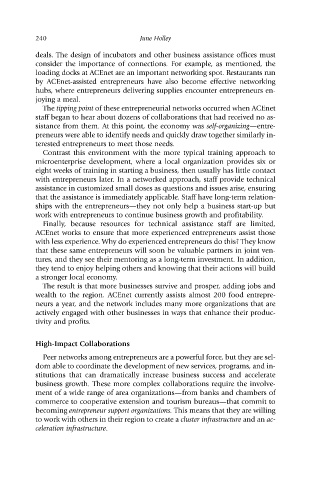Page 251 - 1-Entrepreneurship and Local Economic Development by Norman Walzer (z-lib.org)
P. 251
240 June Holley
deals. The design of incubators and other business assistance offices must
consider the importance of connections. For example, as mentioned, the
loading docks at ACEnet are an important networking spot. Restaurants run
by ACEnet-assisted entrepreneurs have also become effective networking
hubs, where entrepreneurs delivering supplies encounter entrepreneurs en-
joying a meal.
The tipping point of these entrepreneurial networks occurred when ACEnet
staff began to hear about dozens of collaborations that had received no as-
sistance from them. At this point, the economy was self-organizing—entre-
preneurs were able to identify needs and quickly draw together similarly in-
terested entrepreneurs to meet those needs.
Contrast this environment with the more typical training approach to
microenterprise development, where a local organization provides six or
eight weeks of training in starting a business, then usually has little contact
with entrepreneurs later. In a networked approach, staff provide technical
assistance in customized small doses as questions and issues arise, ensuring
that the assistance is immediately applicable. Staff have long-term relation-
ships with the entrepreneurs—they not only help a business start-up but
work with entrepreneurs to continue business growth and profitability.
Finally, because resources for technical assistance staff are limited,
ACEnet works to ensure that more experienced entrepreneurs assist those
with less experience. Why do experienced entrepreneurs do this? They know
that these same entrepreneurs will soon be valuable partners in joint ven-
tures, and they see their mentoring as a long-term investment. In addition,
they tend to enjoy helping others and knowing that their actions will build
a stronger local economy.
The result is that more businesses survive and prosper, adding jobs and
wealth to the region. ACEnet currently assists almost 200 food entrepre-
neurs a year, and the network includes many more organizations that are
actively engaged with other businesses in ways that enhance their produc-
tivity and profits.
High-Impact Collaborations
Peer networks among entrepreneurs are a powerful force, but they are sel-
dom able to coordinate the development of new services, programs, and in-
stitutions that can dramatically increase business success and accelerate
business growth. These more complex collaborations require the involve-
ment of a wide range of area organizations—from banks and chambers of
commerce to cooperative extension and tourism bureaus—that commit to
becoming entrepreneur support organizations. This means that they are willing
to work with others in their region to create a cluster infrastructure and an ac-
celeration infrastructure.

